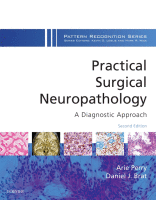Physical Address
304 North Cardinal St.
Dorchester Center, MA 02124

Neurodegenerative disorders are broad ranging and highly complex, with diverse etiologies and frequently overlapping clinical manifestations. The neuropathologic diagnosis of these diseases can be exceedingly challenging even at autopsy when the amount of tissue for examination is not a limiting…

Introduction Reproducible patterns of cerebrovascular injury result from two basic pathologic processes that are occasionally encountered in surgical practice: (1) cerebral infarct resulting from blockage or stenosis of vessels that deprives the brain of oxygen and nutrients and (2) hemorrhage…

Introduction Epilepsy is a common clinical manifestation of a variety of underlying neuropathologic conditions. Most patients can be adequately managed with pharmacotherapy; approximately 75% of patients diagnosed with epilepsy may be ultimately seizure free on medications alone. However, approximately 5%…

Introduction This chapter focuses on the surgical neuropathology of demyelinating diseases (i.e., those diseases in which myelin itself or the oligodendrocyte represents the targeted element with relative axonal sparing), as well as diseases in which white matter is preferentially targeted…

Recognizing a pattern of disease is critical in surgical and autopsy neuropathology, especially for infectious diseases. However, few other central nervous system (CNS) diseases rival infections in their requirement for a multimodal approach—combining clinical, laboratory, and pathology information—in order to…

The nervous system is affected in many familial tumor or “cancer predisposition” syndromes. The genetic and clinicopathologic features are summarized in Table 22.1 . Autosomal dominant inheritance is most common, and the majority of these disorders result from inactivation of…

Introduction Although pathologists typically focus their attention nearly exclusively on the neuropathologic changes of natural disease, therapy-associated neuropathology is increasingly playing a role, particularly now that post-therapy biopsies have become common. To avoid misdiagnosing a host of primary pathologic changes,…

Introduction Most pituitary region masses are pituitary adenomas; however, when other sellar region masses are encountered by clinicians or pathologists, the differential diagnosis can be broad. This chapter will focus on updates for pituitary adenomas, as well as discuss other…

Definitions and Synonyms Melanocytic neoplasms of the central nervous system (CNS) arise from the population of leptomeningeal melanocytes that are scattered throughout the arachnoid membranes. Lesions can manifest as diffuse disseminations within the subarachnoid space or as solid masses, and…

Definition and Synonyms Germ cell tumors (GCTs) are a heterogeneous group that are widely considered to be morphologic and immunophenotypic homologues of germinal neoplasms arising in the gonads and extragonadal sites. The World Health Organization (WHO) classification of GCTs of…